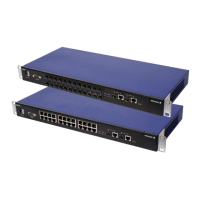Glossary
Arguments:
spanning_tree <type> - The number of defined STP configurations.
Range 1 to 10.
ethernet_port <port> - The number of the Ethernet port. Range 1
to 26.
path_cost <cost> – Set the path cost to the root. Range 1 to 65535.
priority <priority> - Range 0 to 255. Input for calculation of the
path cost and the selection of root port. Priority affects which node
becomes root (the one with lowest value on priority). In an aggregation
network the most central node is the root.
enabled no/yes - If set to no, the function is disabled.
Default Setting
path_cost: 4
priority: 128
enabled: yes
Command Usage
STP is the older of STP and RSTP and should only be used if the EFN is used
where collaborating nodes lack RSTP support.
The Spanning Tree (STP) function is relevant only when the EFN is located in
a network with alternative or redundant links. For example, when there are two
redundant uplinks, or when the EFN is one of several daisy chained switches
with an uplink at each end of the chain.
Up to ten different STP configurations may be defined. The function is then
activated or deactivated on relevant ports by using the add or remove
commands.
In an aggregation network, the most central node is the root. If the EFN is
used in a daisy chained topology, it is important that the EFN does not
become the root. Prevent the EFN from becoming root by ensuring that there
is a central node with a higher priority.

